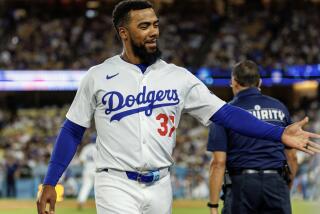It was the granddaddy of all Los...
- Share via
It was the granddaddy of all Los Angeles’ country clubs, a lavish 208-acre resort in the San Gabriel Valley where kings and generals rode hellbent-for-leather on manicured polo fields and sipped champagne on the terrace of the Colonial-style clubhouse.
Built in 1912, the Midwick Country Club, on the border between Monterey Park and Alhambra, reigned for more than three decades as the most exclusive polo club in the region.
King George V of England once played on the club’s polo fields and Gen. George Patton Jr. was a frequent competitor with his Army team.
On Sundays, the sharp crack of polo mallets smacking the ball down the field filled the air. Movie stars and socialites flocked to the club in limousine caravans to watch polo matches.
Will Rogers, Hal Roach, David Niven, Spencer Tracy and Walt Disney were among the many celebrities often seen playing polo, although Tracy was later banned by his insurance company from playing the dangerous sport.
The Midwick Country Club, established by a dozen or so wealthy charter members, was built on a series of rolling hills that had been used as a sheep pasture.
For the Sport of Kings and the King of Sports, a regulation-size polo field (450 by 900 feet), lined by eucalyptus trees, was built along Hellman Avenue. The clubhouse with four guest apartments, tennis courts, two smaller polo fields and a swimming pool were added. The cost came to $500,000.
The name Midwick was chosen because of its English meaning, “midway.” It was about equal distance from Los Angeles and Pasadena, where most members lived.
Membership was extremely selective and for whites only. The initiation fee was a staggering $3,800, just about what a house cost at the time. The monthly dues were $22.50.
The club quickly became a center of power, where money and clout were taken for granted. Polo was at the heart of it all.
Just before the Depression, America’s top poloist, Tommy Hitchcock, said during an interview that he considered Midwick the “best that I have ever played on in this country.”
The club’s team, the Midwick Foursome, was one of the most feared in the country. Made up of Eric Pedley, Arthur Perkins, Carleton Burke and E. G. Miller, the team was cheered by every West Coast polo enthusiast and won the national polo title in 1924.
During the 1932 Olympics, several major equestrian events were held at Midwick, including the Hunter-Jumper and the Grand Prix competitions.
Along with the triumphs, tragedy also struck at Midwick. Top British star Pat Roark was killed in 1939 when his pony rolled over him during a duel with Pedley.
Although polo was the club’s focus, renowned golfers and tennis players also were drawn to the club’s world-class facilities.
Golf luminaries, such as Sam Snead and Bing Crosby, could often be seen on the fairway. Several tennis champions, including Donald Budge and Ellsworth Vines, won their first matches as teen-agers at Midwick.
Midwick’s decline began with the Great Depression. Fortunes were lost, vast empires destroyed and membership began to dwindle.
By 1940, it became clear that the club’s glory days were over. The club defaulted on a loan in 1941 and was sold at auction for $178,000 to an Italian immigrant named Dominic Jebbia.
Jebbia had amassed a fortune in the banana business and was called the “Banana King.”
His 18-acre hilltop home on Fremont Avenue adjoined the country club’s property. Jebbia once said he considered Midwick “sort of my back yard.”
It was rumored that Jebbia had bought Midwick to spite club members who rejected his application for membership. But Jebbia denied the rumor, saying: “This is just a real estate deal to me. I bought it, cash on the barrelhead, to preserve the view.”
Jebbia changed the club’s name to the Southern California Golf Club. He relaxed on weekends by selling hot dogs on the ninth hole.
Most golfers had no idea that the cigar-chewing hot dog vendor, who doled out liberal quantities of philosophy and advice along with the relish, actually owned the club. An old-time golfer recalled that one of Jebbia’s daughters, dressed in a mink coat, once helped him sell hot dogs on a cold day.
On May 3, 1944, the clubhouse was destroyed by fire. Jebbia lost little time in subdividing the property.
He sold 180 acres to lumberman Charles M. Cooper, who for four years managed the golf course. Cooper donated part of the land to Los Angeles County for Granada Park. The rest of Midwick’s manicured grounds were covered by concrete and suburban tract homes.
Today, the only traces left of the great Midwick Country Club are the names of famous polo and golf stars that grace the streets in the area, such as Hitchcock, Snead and Roark drives.
More to Read
Go beyond the scoreboard
Get the latest on L.A.'s teams in the daily Sports Report newsletter.
You may occasionally receive promotional content from the Los Angeles Times.










